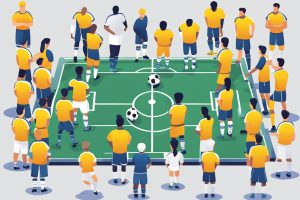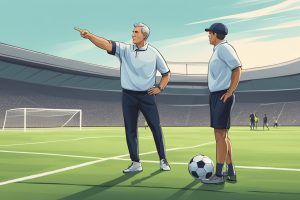Soccer Defending Body Position: How to Position Yourself to Stop Your Opponent’s Attack
Soccer is a game of strategy, teamwork, and skill. One of the most crucial aspects of the game is defense. A strong defense can make the difference between winning and losing a match. When it comes to soccer defense, body positioning is key. A player’s body position can determine whether they can stop an opposing player from scoring or not.

Body positioning techniques are essential for effective soccer defense. Players must learn how to position their bodies to prevent the opponent from getting past them. This involves keeping their body low, their eyes on the ball, and their feet shoulder-width apart. By positioning their body correctly, players can block the opponent’s path to the goal and force them to make a mistake.
Key Takeaways
- Body positioning is a crucial aspect of soccer defense.
- Proper body positioning involves keeping the body low, eyes on the ball, and feet shoulder-width apart.
- Effective body positioning can block the opponent’s path to the goal and force them to make a mistake.
Body Positioning Techniques
Block the Line to Goal
One of the most important aspects of defending in soccer is to block the line to goal. This means that the defender must position themselves between the attacker and the goal. To do this effectively, the defender must have a low center of gravity and be able to shuffle quickly from side to side. By doing so, they can effectively block the attacker’s path to the goal and force them to move the ball to another area of the field.
Stance and Balance
A good defensive stance is essential for effective body positioning in soccer. The defender should keep their knees slightly bent and their weight on the balls of their feet. This helps to maintain balance and allows the defender to react quickly to any changes in the attacker’s movement. The defender should also keep their chest out and their head up, which helps to maintain good posture and allows them to see the field more clearly.
Movement and Agility
In addition to having good body positioning, a defender in soccer must also be able to move quickly and with agility. This means that they must be able to shuffle quickly from side to side, move forward and backward, and change direction quickly. By doing so, they can effectively stay with the attacker and prevent them from getting past them.
Overall, effective body positioning is essential for success in soccer defending. By maintaining a low center of gravity, keeping their knees bent, and shuffling quickly from side to side, defenders can effectively block the line to goal and prevent attackers from getting past them. Additionally, a good defensive stance and the ability to move quickly and with agility are also essential for effective body positioning in soccer.
1v1 Defending Tactics
When it comes to defending in soccer, one of the most challenging situations for defenders is the 1v1 scenario. In this situation, the defender is left alone to deal with an opponent who has the ball and is trying to get past them. To be successful in 1v1 defending, defenders need to have a combination of good defensive stance, pressure, and tackling techniques.
Closing Down the Attacker
The first step in 1v1 defending is to close down the attacker. This means that the defender needs to get close to the opponent, putting them under pressure and making it more difficult for them to dribble or pass the ball. To do this, the defender needs to take a side-on stance, with their knees slightly bent and weight on the balls of their feet. This stance allows the defender to move quickly in any direction and helps them to maintain balance while closing down the attacker.
Jockeying and Delaying
Once the defender has closed down the attacker, the next step is to jockey and delay. Jockeying involves moving side to side, mirroring the movements of the attacker, and keeping them in front of the defender. This helps to prevent the attacker from getting past the defender and into a dangerous position. Delaying involves slowing down the attacker’s progress, giving the defender time to get back into position and support from other defenders.
Tackling Techniques
When it comes to tackling in 1v1 defending, timing is everything. A well-timed tackle can win the ball back for the defender, but a mistimed tackle can lead to a foul or a dangerous situation. Defenders need to be patient and wait for the right moment to make a tackle. When making a tackle, the defender should aim to get their body between the attacker and the ball, using their feet to make contact with the ball and not the opponent.
In conclusion, 1v1 defending requires a combination of good defensive stance, pressure, and tackling techniques. By closing down the attacker, jockeying and delaying, and using well-timed tackles, defenders can successfully defend against even the best attackers in the game.
Team Defending Strategies
When it comes to soccer defending, individual skills and tactics are important, but teamwork and communication are equally crucial. A team that works cohesively and communicates effectively is more likely to succeed in thwarting the opposition’s attack. Here are some key team defending strategies to keep in mind:
Communication and Support
Effective communication is essential for a strong defense. Defenders need to be able to communicate with each other to coordinate their movements and cover the gaps in the defense. They also need to provide support to each other, both verbally and physically. For example, if a defender is beaten by an opposing player, another defender can provide cover by stepping in to challenge the attacker.
Defensive Shape and Cohesion
Maintaining a strong defensive shape is important to prevent the opposition from creating scoring opportunities. The defenders need to work together to maintain a compact shape, with the midfielders dropping back to provide additional support. This helps to deny the opposition space and time on the ball, making it more difficult for them to create chances. Defensive drills can be used to help players develop their positioning and movement off the ball.
Transitioning to Counterattack
A strong defense can also be a potent weapon in the attack. When the team wins possession of the ball, the defenders can quickly transition into a counterattack, using their speed and passing skills to launch a swift attack on the opposition. This can catch the opposition off guard and create scoring opportunities.
In summary, effective team defending requires teamwork, communication, and support, a strong defensive shape, and the ability to transition quickly to the counterattack. By working on these strategies in training, teams can develop a cohesive and effective defense that can help them to win games.
Defensive Skills and Drills
Defending in soccer requires a combination of skills and drills that help players master the art of interception, clearance, and position-specific training. Here are some of the essential skills and drills that coaches can use to improve their team’s defensive performance:
Interceptions and Clearances
Interceptions and clearances are two of the most crucial defensive skills in soccer. Players need to be able to read the game and anticipate the opposition’s moves to make successful interceptions. Similarly, clearing the ball from danger areas is a critical skill for defenders. Coaches can use drills like the “Defensive Clearances Drill” to help players improve their clearance skills.
Defensive Heading
Heading is an important part of soccer, and defenders need to be able to head the ball accurately and with power. Coaches can use drills like the “Heading for Height Drill” to help players improve their defensive heading skills. The drill involves players jumping and heading the ball at the highest point possible.
Position-Specific Training
Position-specific training is an essential part of soccer coaching, and it is particularly important for defenders. Coaches can use drills like the “One-on-One Defending Drill” to help players improve their individual defending skills. The drill involves pairing players up and placing them face-to-face, with the defender’s goal being to stop the attacker from passing through them.
In conclusion, mastering the art of defending in soccer requires a combination of skills and drills that coaches can use to improve their team’s performance. By focusing on interception, clearance, heading, and position-specific training, coaches can help their players become confident and knowledgeable defenders.
Preventing Common Mistakes
When it comes to soccer defending, there are a number of common mistakes that players often make. However, by maintaining proper body shape, avoiding diving in, and being aware of their position on the field, players can greatly reduce the likelihood of making these mistakes and increase their effectiveness as defenders.
Maintaining Proper Body Shape
One of the most important aspects of soccer defending is maintaining proper body shape. This means keeping the body in a position that allows the defender to quickly change direction and react to the attacker’s movements. To achieve this, defenders should keep their knees slightly bent and their weight balanced on the balls of their feet. This will allow them to quickly shift their weight from one foot to the other and move in any direction as needed.
Avoiding Diving In
Another common mistake that defenders make is diving in to try and win the ball. While this can be effective in some situations, it can also leave the defender vulnerable to being beaten by a skilled attacker. Instead, defenders should focus on staying on their feet and using their body position to block the attacker’s path to the goal. This will allow them to maintain control of the situation and make a more effective tackle when the time is right.
Positional Awareness
Finally, defenders need to be aware of their position on the field at all times. This means knowing where the other defenders are, where the attacker is, and where the ball is. By maintaining this awareness, defenders can position themselves in a way that makes it difficult for the attacker to get past them. They can also anticipate where the attacker is likely to go and be in a better position to intercept the ball.
In summary, by maintaining proper body shape, avoiding diving in, and being aware of their position on the field, defenders can greatly reduce the likelihood of making common mistakes and increase their effectiveness as defenders.
Physical and Mental Preparation
When it comes to soccer defending, physical and mental preparation are equally important. A defender needs to be physically fit and mentally focused to perform at their best. In this section, we will discuss the key aspects of physical and mental preparation for soccer defenders.
Fitness and Conditioning
Defenders need to be in top physical condition to keep up with the pace of the game. They should have good endurance to be able to sprint, jump, and change direction quickly. A defender’s fitness level also plays a key role in their ability to recover quickly and maintain their performance throughout the game.
To achieve optimal fitness, defenders should engage in regular physical training that includes cardiovascular exercises, strength training, and agility drills. They should also maintain a healthy diet and stay hydrated to ensure their body is functioning at its best.
Building Confidence and Focus
Confidence and focus are critical for any defender. Defenders need to have confidence in their abilities to make quick decisions and react to the opponent’s moves. They should also be able to maintain their focus even under pressure.
To build confidence and focus, defenders can practice visualization techniques. They can imagine themselves making successful tackles, intercepting passes, and scoring goals. Defenders can also practice meditation and breathing exercises to stay calm and focused during the game.
In conclusion, physical and mental preparation are essential for soccer defenders to perform at their best. By maintaining good fitness and conditioning, as well as building confidence and focus, defenders can improve their performance on the field.
Fundamentals of Soccer Defending
Understanding Defending in Soccer
Defending is a crucial part of soccer that requires a great deal of skill and knowledge. A defender’s primary responsibility is to prevent the opposing team from scoring by intercepting passes, blocking shots, and tackling players. In order to do this effectively, defenders must have a strong understanding of the game and be able to anticipate the actions of the opposing team.
One of the most important aspects of defending in soccer is body positioning. A defender’s body position can make all the difference in preventing the opposing team from scoring. Proper body positioning involves standing in a way that allows the defender to move quickly and efficiently, while also blocking the opposing player’s path to the goal.
Key Defensive Positions
There are several key defensive positions in soccer, each with its own unique responsibilities. The central defender, for example, is responsible for marking the opposing team’s center forward and preventing them from scoring. The fullback, on the other hand, is responsible for defending the sides of the field and preventing opposing players from crossing the ball into the box.
In addition to these positions, there are also other defensive roles that players can take on, such as the sweeper or the defensive midfielder. These players are responsible for providing additional support to the defense and helping to prevent the opposing team from scoring.
Overall, defending in soccer is a complex and challenging task that requires a great deal of skill and knowledge. By understanding the fundamentals of defending and key defensive positions, players can improve their ability to prevent the opposing team from scoring and ultimately help their team win.
Frequently Asked Questions
What are the key principles of effective soccer defense strategy?
Effective soccer defense strategy involves a combination of techniques and tactics that aim to prevent the opposing team from scoring goals. The key principles of effective soccer defense strategy include maintaining good body position, staying alert, communicating with teammates, and being patient.
What techniques should beginners focus on to improve their soccer defending skills?
Beginners should focus on learning the basics of body positioning, tackling, and marking. They should also work on improving their agility, speed, and reaction time. Practicing these skills regularly can help beginners develop a solid foundation for their soccer defending abilities.
What are effective 1v1 defending tactics in soccer?
Effective 1v1 defending tactics in soccer involve staying focused, maintaining good body position, and anticipating the opponent’s moves. Defenders should aim to force the attacker away from the goal and prevent them from getting into a scoring position. Tackling should be used as a last resort, and defenders should try to jockey and contain the attacker instead.
How should a player’s body be oriented when defending in soccer?
A player’s body should be oriented towards the ball and the opponent they are marking. They should be on their toes, with their knees slightly bent, and their weight balanced on both feet. Their arms should be held out to the sides for balance and to prevent the attacker from getting past them.
What drills can help improve a soccer player’s 1v1 defending abilities?
Drills that can help improve a soccer player’s 1v1 defending abilities include shadow defending, where the defender practices staying close to the attacker without tackling, and 1v1 defending drills, where two players practice defending against each other. These drills can help players improve their body positioning, movement, and tackling skills.
What should a defender be aware of in terms of positioning on the soccer field?
Defenders should be aware of their position on the field and their relationship to the ball and their opponents. They should aim to stay between the ball and the goal, and to mark their opponents closely. They should also communicate with their teammates to ensure that they are covering all areas of the field and are aware of any potential threats.







